 Hollyhocks on Way to Bakers |
First port of call was the bakers we had spotted the previous evening. I chose a loaf coated in nuts of some variety, and asked the young woman who served to slice it for me. I praised her on her good command of English. "I always found languages difficult," she said, "and I could never write in a foreign language. But I was told to always practice, practice, practice and then practice more the spoken word. That was how I learned to speak English. But foreign people find Dutch difficult," she added. "There are many words with double meanings which make it hard for foreigners. Also the humour is difficult to convey." Fortunately, other customers had arrived, otherwise I would have been there all morning.
Then, as I headed to the Spar, I passed a guitar shop, and of course I tarried there for a while before tackling the Spar.
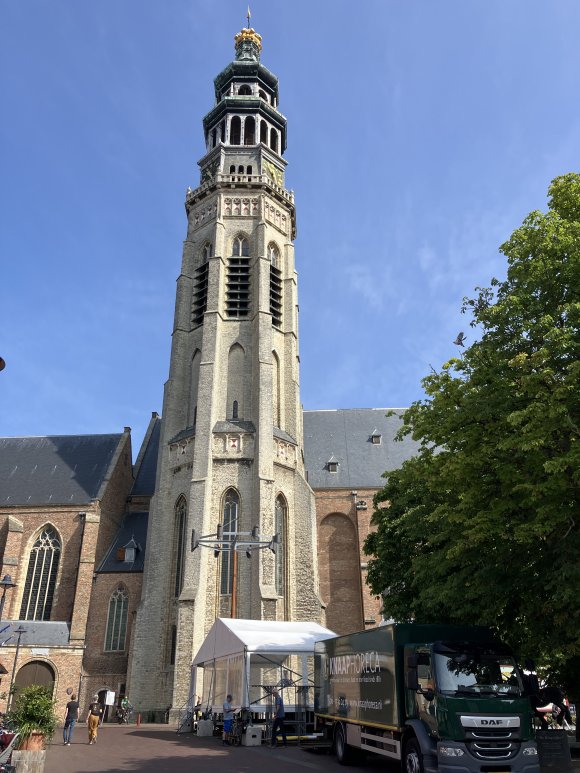 Lange Jan |
In 1127 Norbertine came to Middelburg. These monks were followers of Norbert of Xanten. They established here the Premonstratensian from St. Michael's Abbey in Antwerp. For four centuries (until 1570) the monks worked on their Norbertine abbey. They expanded the complex into what it was today: churches, religious spaces, cloisters, stair towers and vaults. It was like a ring of impressive architecture around the central Abdijplein (Abbey Square). The whole was crowned by the 91m tall abbey tower, "Lange Jan" (Tall John), regarded by many as the ultimate symbol of Middelburg. Three churches were contained in a cluster in the complex: the 14th-century Koorkerk (Choir Church), the 16th-century Nieuwe Kerk (New Church) with a famous 16th century organ, and the 17th-century Wandelkerk which held the tombs of Jan and Cornelis Evertsen, admirals and brothers killed fighting the English in 1666. The northern section housed the Zeeuws Museum, renovated in 2007 by a well-known Belgian architect. The museum contained fine collections of china, silver and paintings, and tapestries. The vast inner courtyard, the Abdijplein, behind the churches was immaculate, as to be expected in the Netherlands, and echoed of history. Tall trees stood proudly waving in the breeze, and ancient gates led out into the old city.
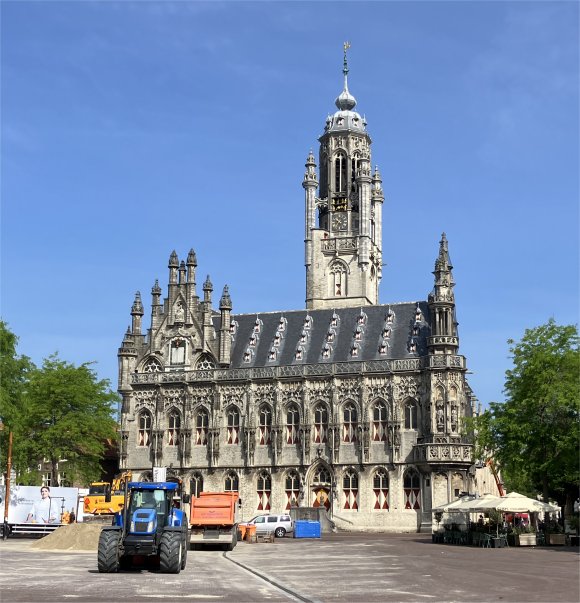 Stadhuis |
I passed back through the Stadhuis Markt. Proudly dominating the market square stood the Stadhuis. This late Gothic building, built between 1452 and 1458 by members of the Keldermans family, was the architectural jewel of the city, reflecting the Flemish influence of the late medieval period. Between 1506 and 1520 a Meat Hall and a tower were added, and in 1670 and 1780-84 there were further additions in neo-classical style. The Town Hall was almost completely destroyed in the 1940 bombing, but after the war was rebuilt in the original style. On the fašade of 1512-13, most of which survived the bombing, were figures of 25 Counts and Countesses of Zeeland and Holland, the Burundian rulers of the time, under canopies surmounted by fabulous animals. The windows and doors were closed by red and white shutters - a common practice in the Middle Ages, when windows were not glazed. The more-classical portion on Lange Noordstraat, also part of the outer concentric ring, dated from the 1600s.
 Molen de Hoop |
But we couldn't watch boats all day, so I took Rex on a long hike following the outmost canal that encircled the town - the girth of the town, hence the street names all ended in -singel. We took in thee mills during our hike: Molen de Hoop, De Seismolen and Molen de Koning.
 De Seismolen |
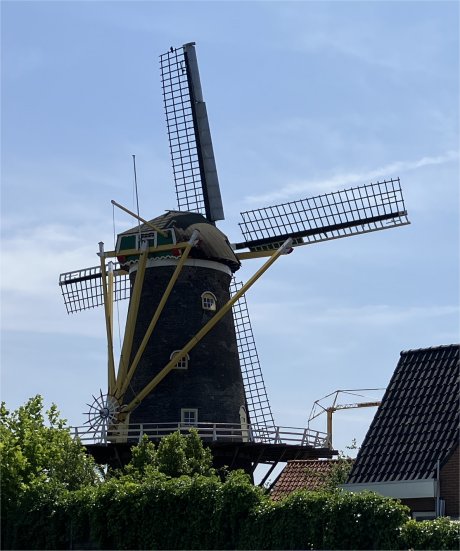 Molen de Koning |
The Seismolen is a former flour mill at the Seisbolwerk. It is a round stone shelving mill that was built in 1728 and is the oldest of the windmills still present in Middelburg. After a severe storm in November 1940 and subsequent neglect, the mill fell into disrepair. From 1955, when the mill came into the property of the municipality, the masonry was restored.
Molen De Koning originally stood at the end of the Winterstraat , on the southwest point of the historic city centre. During the construction of the Canal by Walcheren, the mill was moved to the Veerseweg in 1867. The current mill on the Veerseweg was built in 1882 after the predecessor had burned down. The mill remained in operation using wind power until 1938. Since 1998, the mill has been in operation on a voluntary basis. This mill is also owned by the municipality of Middelburg. The mills were interesting to look at, but sadly none were open to the public.
 Koepoort |
At the beginning of the 20th century, two families lived in the Koepoort in two identical small spaces. During WWII there was a small shop and the German occupiers tried to install a radio disruptor. After the war, the Koepoort came into use as the home of Korstanje couple, they lived in the Koepoort until July 1969. After this it was empty for several years, but in 1980 until 2016 it was used as a studio and home of the artist Leendert van der Pool. In 2018, the Koepoort was internally converted into two B&B apartments under the supervision of architect Bernard Vercouteren, and these were put into use in 2019.
It was while we were standing on the Koepoortbrug we witnessed a herd of sheep being led by a shepherdess and dogs along the path to another stretch of the canal bank where they would graze.
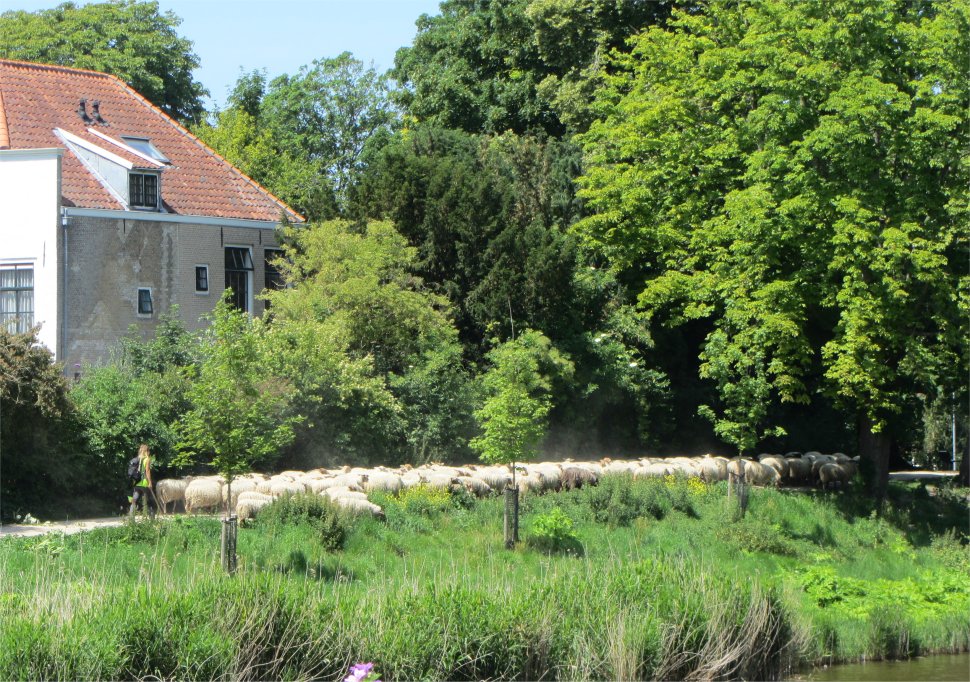 Sheep Herding by the Koepoortbrug |
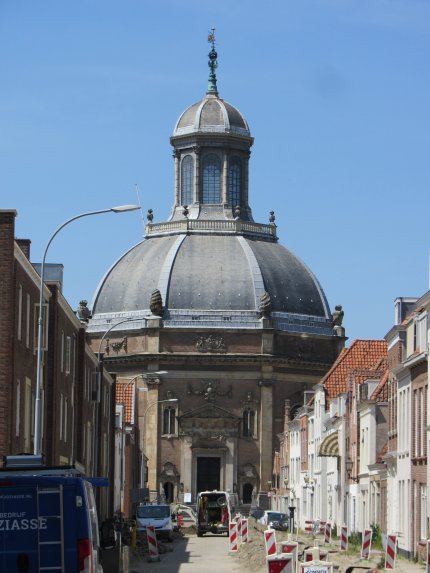 Oostkerk |
This church with the round dome has stood out in the silhouette of Middelburg for centuries. It arose at a time when the city was doing well and survived the centuries that followed virtually unscathed. Nowadays the building provides a stage for cultural events.
Evening was spent at the same restaurant we had visited the previous evening; the food was good and the staff communicative.
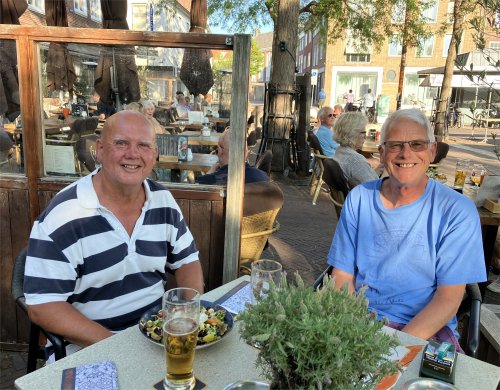 Meal in Stadhuis Markt |
